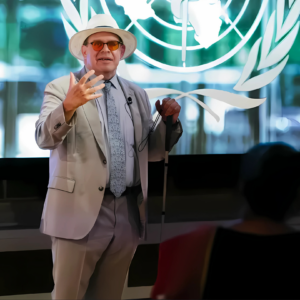 Our conversation with Christopher Bailey is part of a series of features
Our conversation with Christopher Bailey is part of a series of features
with Americans working for the World Health Organization.
Follow our social media for more.
Laughter may be the best medicine, but what about singing, painting and dancing?
There is a growing body of evidence that arts-based interventions are effective treatments for a range of health conditions, including postpartum depression, chronic pain and anxiety.
Working at the intersection of science, arts and healing is Iowa-native Christopher Bailey. Since 2019, the former stage actor has been leading a World Health Organization (WHO) program to support government and health systems research, programs and policies that focus on embracing the arts as an essential part of wellbeing and recovery.
We spoke with Bailey about the WHO arts and health program and how it’s supporting a healthier population here in the U.S.
Bailey’s answers have been edited for length and clarity.
How did the WHO arts and health program come to be?
 Bailey: As the coordinator of online communications for the WHO since 2012, I had opportunities to use theater techniques as a form of community engagement and saw how that revolutionized clinical work in Africa. I was also helping to run an expat theater company in Geneva, working to fold health and development themes into plays. It was clear it was sparking positive community conversations that had never happened before on topics like intergenerational trauma and suicide prevention. When I proposed the program to WHO Director-General Dr. Tedros Ghebreyesus to do a deep dive into the research and connect with the health professionals who have been utilizing arts to improve health, he agreed.
Bailey: As the coordinator of online communications for the WHO since 2012, I had opportunities to use theater techniques as a form of community engagement and saw how that revolutionized clinical work in Africa. I was also helping to run an expat theater company in Geneva, working to fold health and development themes into plays. It was clear it was sparking positive community conversations that had never happened before on topics like intergenerational trauma and suicide prevention. When I proposed the program to WHO Director-General Dr. Tedros Ghebreyesus to do a deep dive into the research and connect with the health professionals who have been utilizing arts to improve health, he agreed.
How has WHO augmented the body of evidence backing the relationship between art and health?
Bailey: Because WHO is a scientific and technical organization, I co-created the Jameel Arts and Health Lab with NYU and an NGO called Culturunners, a consortium of research centers around the world that look at rigorous studies of artistic interventions designed to improve health in a physical, mental or social aspect. We are also looking at the basic science of how art improves health. What is the neurology and biochemistry happening under the hood and the mechanism of art as a health benefit? In the U.S., our research partners include the NYU/Steinhardt Creative Arts Therapies Consortium, Johns Hopkins University’s International Arts + Mind Center for A Neuroaesthetics and the University of Florida’s EpiArts Lab.
In 2019, the WHO published its first ever report pulling together significant existing research on the role that arts play in improving health. What impact has that had American’s health?
Bailey: The WHO’s publication of that report had a lightning rod effect on the sector, in that it changed the space all over the world, including the U.S. People started taking it more seriously. We now have healthcare providers and lawmakers in communities and states – like Arkansas, Georgia, Massachusetts and New York – talking about ways to implement a ‘social prescribing’ framework that includes the healing arts in public health.
Can you give some examples of how that has manifested in the U.S.?
Bailey: We collaborated with a national arts and health initiative called One Nation, One Project that supported local artists working with community health leaders in 15 states and the District of Columbia. We’ve had healing arts conferences in Atlanta with WHO Goodwill Ambassador and opera singer Rene Fleming and Georgia State Representative Kim Schofield. We had a panel at Lincoln Center in New York City on a series of discussions about the connection of art and wellbeing. And right now, New York state’s legislature is considering a bill that would enable Medicaid to cover the services of creative art therapists. Four states – Arizona, California, New Mexico and Oregon – already have Medicaid reimbursement for native traditional healing practices like music therapy, sweat lodges and dancing to help with physical and mental health.
Did you have your own experience with the power of arts as a healing intervention?
I was diagnosed with cancer many years ago and was sick from chemotherapy. To get through it, I wrote a play. When I was on stage, I felt this profound sense of wellness. Maybe it was the analgesic effect or a distraction or focus, but it gave a negative experience an authentic personal meaning that helped with my physical recovery.
Can you take us back to a personal ‘a ha’ moment that led you to this work?
Bailey: There wasn’t really an ‘a ha’ moment. It was all about problem solving. When I was WHO’s Health Informatics coordinator, I was seeing that many of our clinical aid programs weren’t gaining real traction, so I thought, let’s try something different. How can I engage in a dialogue to create together?
Christopher Bailey is indeed trying something different – cocreating new artforms and platforms to give voice to the lived experiences of all those working to make meaning of illness. And both the people and the research behind his efforts are a testament that the often challenging process of healing can itself be a powerful work of art.
A very special thanks to Christopher for his reflections.